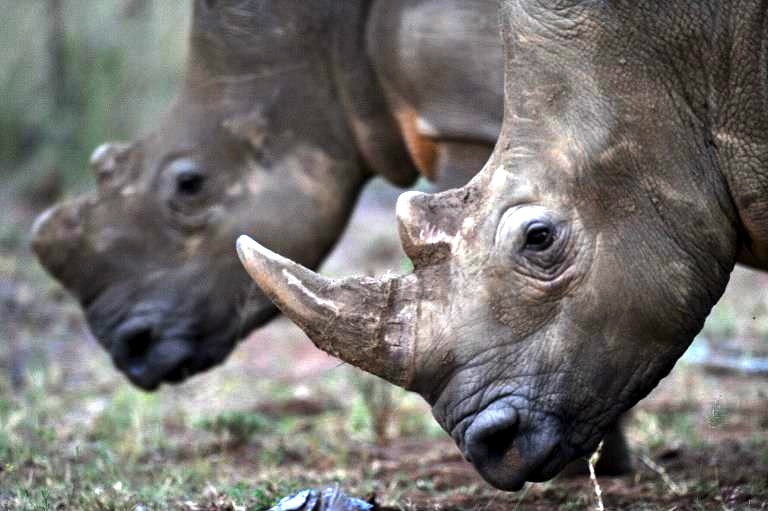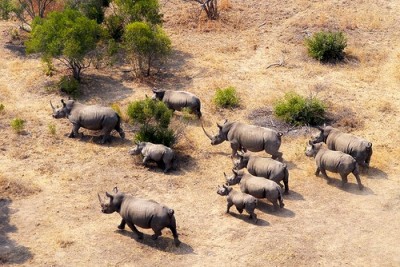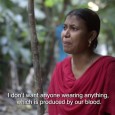Baobab trees stand in abundance with lush yellow grass swaying at their trunks. Grey Loerie birds float between trees in the clear blue air while insects faintly hum from the earth. The bushveld: home to the Big Five, a place of enchantment and serenity and the setting for Africa’s biggest ecological disaster.
In the thick shrubbery, tourists often miss them entirely, but not poachers.
One of the few remaining Jurassic-looking species on earth is now facing extinction. These one-and-a-half ton docile herbivores are dying at an average rate of 2.4 per day in Southern Africa, facing wipe-out not due to bushfires, flooding or disease but because of the malice of humanity.
This is the battle of the rhinoceros: innocent hosts to ivory that per ounce is now worth more than gold. Unsurprisingly, rhino horn has been coined as Africa’s new Blood Diamond.
In the late 1800s, it was believed that the white rhino in the wild was extinct. A magnificent discovery of a small herd in South Africa’s Kwa-Zulu Natal Province excited Africa at large. Driven by Dr Ian Player, extensive conservation programs, breeding schemes and relocation busied South African conservationists for many decades – and with significant reward. By 1960, there were well over 600 wild rhinos in South Africa, with a growing population.
However, nearly a century of hard work by conservationists has been rapidly undone as poachers carelessly hack rhinos to death, horn by horn, day after day…
Since 2008, poaching has rocketed throughout Africa. The 83 rhinos poached in South Africa in 2008 raised alarm bells but this was minor compared to the 668 that died at the mercy of poachers last year, a number that made even the South African Parliament wake up.
But what drives poachers to ruthlessly slaughter these majestic, defenceless creatures? Money, of course, and superstition.
These hit men of the savannah are paid well for their hacking services. And the market for rhino horn, although elite, is extensive. The main culprit for ivory trafficking is the Far East, particularly Thailand and Vietnam. In these nations, the rhino horn is smuggled from Africa and sold as an exclusive aphrodisiac. Unlike elephant ivory, rhino horn is believed to have a unique composition so it is finely grounded and used in several “medications”.
Mr Gerard Smit, chairperson of AIKONA (Against Interference in Kruger and other National Assets), is actively fighting against poaching. “Whether it is traditional or a medicine, the bottom line is that it is unacceptable what they do to animals – no matter what people believe in,” Gerhard says.
Like hundreds of other anti-poaching organisations in South Africa, Gerhard blames the government for turning a blind eye to the slaughter. In his opinion, the government is purely “all talk, no action” and is passively sitting back in its leather seats in parliament, watching as the rhino species becomes irreversibly extinct.
“SANParks (South African National Parks) cannot tackle poaching alone, they need government support,” Gerhard says. “People forget that game rangers aren’t soldiers.”
Unfortunately, many of the poachers are ex-soldiers and rhinos face an unfair battle. A public outcry in South Africa has urged the army to be deployed to protect rhinos. However, Gerhard is skeptical that this is a viable solution since the security forces (like parliament) lack not only training, but also motivation.
“There is a lack of political will power to tackle poaching, quite literally, by the horns,” he says.
Even when poachers are caught, the legal system fails the rhino. In addition to the fact that legal proceedings are lengthy, Gerhard argues that bail for poachers is granted “too easily” and the dismally small fines are “too easily paid”.
Local newspapers in South Africa are often smeared with grotesque images of the poacher aftermath. Unsurprisingly, the (unsuccessful) public consensus has been to introduce the death penalty for these vicious perpetrators.
But despite the frantic public pleas, conservationists have chiefly been left to devise solutions to the poaching phenomenon. A common practice by private game farm owners is to surgically remove the horn from its cavity. Rhino horn is mostly calcium and melamine and is without nerve (often compared to a fingernail). Gerhard is not convinced that removing the horn is the best solution, but admits that it is saving some rhinos from brutal slaughter.
Jacqui Fourie’s family owns a game farm that borders the Kruger National Park. On their farm, they remove the horns of their 12 rhinos, every two to three years as needed, in a desperate attempt to save their rhinos’ lives.
“Removing the horn is costly, but saving the species is priceless,” says Jacqui.
The Fourie farm, like many other private reserves, is under constant surveillance by privately hired game rangers – and, unfortunately, by lurking poachers too. An attempted poaching left one of the Fourie rhinos seriously injured and eventually a vet had to put the suffering animal down.
Jacqui explains in horrific detail how poachers often dismember rhinos alive. “Poachers get away literally with murder. I fear my kids, never mind my grandkids, will only know the Big Four and never get to see rhinos because of the rate of poaching.”
The battle against poaching has been lost throughout the continent. East Africa was also once rich in rhino, but only a handful remain. In May this year, Mozambique grotesquely lost its last wild rhino to brutal poaching. The situation is so dire in Kenya that there was a serious but unsuccessful attempt recently to legalise the ivory trade in the hope it would save the species. In April, the suggestion to legalise the ivory trade was also raised in South Africa and is currently sluggishly under parliament’s “scrutiny”.
Since the government is not being proactive in addressing poaching, some conservationists have in the last two months decided to take what they hope are ‘deadly’ measures by “thinking pink”.
This involves drilling a small hole in the horn while the rhino is tranquilised and injecting pink dye and parasiticide (a strong pesticide) into the horn. The rhino is supposedly unaffected, flagging only a visible pink patch, signalling to poachers its ruined horn. But a consumer of the poisoned ivory will fall ill: severe diarrhea, nausea and atrocious stomachaches. Although not proven to be deadly to consumers, it is the latest desperate attempt to discourage buyers and help end the ivory trade.
For now, the world is merely a spectator, a passive witness to the circus unfolding in the African savannah. In Gerhard’s words, the beautiful bushveld, with its boastful baobab trees, glorious wildlife, superb stretches of savannah and unique ecology has merely become a poacher’s paradise.








